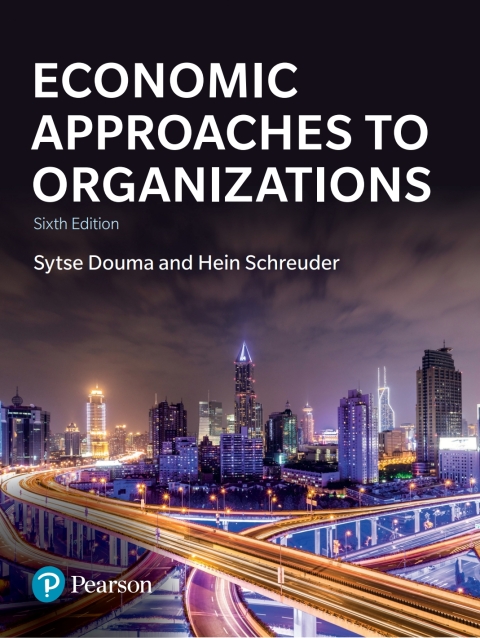Description
Efnisyfirlit
- Half-Title page
- Title page
- Copyright page
- Contents
- Preface
- Acknowledgements
- Part I Foundations
- 1 Markets and organizations
- 1.1 The economic problem
- 1.2 The division of labour
- 1.3 Specialization
- 1.4 Coordination
- 1.5 Markets and organizations
- 1.6 Information
- 1.7 The environment and institutions
- 1.8 Historical perspective
- 1.9 Summary: the conceptual framework of this book
- 1.10 Outline of the book
- Questions
- Note
- 2 Markets
- 2.1 Introduction
- 2.2 Market interaction: analysis of demand and supply
- 2.3 Decision-making by consumers
- 2.4 Decision-making by producers
- 2.5 Market coordination
- 2.6 The paradox of profits
- 2.7 Competitive markets
- 2.8 The main assumptions underlying standard microeconomic theory
- 2.9 Summary: how according to standard microeconomic theory economic decisions are coordinated by th
- Questions
- 3 Organizations
- 3.1 The world of organizations
- 3.2 Organizational coordination
- 3.3 Types of organizations
- 3.4 Organizational markets
- 3.5 Organized markets
- 3.6 The rise of the Internet and the digitization of organizations
- 3.7 Digital platforms: a new coordination mechanism
- 3.8 The Platform Organization
- 3.9 Summary: how organizations achieve coordination
- Questions
- Notes
- 4 Information
- 4.1 Coordination and information
- 4.2 Hidden information
- 4.3 Hidden action
- 4.4 The value of information
- 4.5 Information as an economic good
- 4.6 Summary: information problems for markets and organizations
- Questions
- Notes
- 5 Game theory
- 5.1 Introduction
- 5.2 The prisoner’s dilemma
- 5.3 Coordination games
- 5.4 The entry game
- 5.5 The iterated prisoner’s dilemma
- 5.6 Auctions
- 5.7 Evolutionary game theory
- 5.8 Summary: insights from game theory
- Questions
- 6 Econs and Humans
- 6.1 Introduction
- 6.2 The social domain versus the economic domain
- 6.3 Economic, social and moral man: bounds on self-interest
- 6.4 Bounds on rationality
- 6.5 Prospect theory
- 6.6 Summary: behavioural economics
- Questions
- Part II Economic Approaches
- 7 Behavioural theory of the firm
- 7.1 Introduction
- 7.2 The firm as a coalition of participants
- 7.3 Organizational goals
- 7.4 Organizational expectations
- 7.5 Organizational choice
- 7.6 From bounded rationality to behavioural economics
- 7.7 Summary: goals and decision-making within the firm in behavioural theory
- Questions
- Note
- 8 Agency theory
- 8.1 Introduction
- 8.2 Separation of ownership and control
- 8.3 Managerial behaviour and ownership structure
- 8.4 Entrepreneurial firms and team production
- 8.5 The firm as a nexus of contracts
- 8.6 Theory of principal and agent
- 8.7 Applying agency theory
- 8.8 Summary: agency relations between owners, managers and employees
- Questions
- Note
- 9 Transaction cost economics
- 9.1 Introduction
- 9.2 Behavioural assumptions: bounded rationality and opportunism
- 9.3 Dimensions of transactions
- 9.4 Peer groups
- 9.5 Simple hierarchies
- 9.6 Multistage hierarchies: U-form and M-form enterprises
- 9.7 Organizational markets
- 9.8 Digitization and transaction costs
- 9.9 Markets and organizations: are these all there is?
- 9.10 Governance in a three-level schema
- 9.11 Summary: effect of transaction costs on choosing between markets and organizations and organiza
- Questions
- Notes
- 10 Economic contributions to business/competitivestrategy
- 10.1 Introduction
- 10.2 Industry analysis
- 10.3 Competitor analysis
- 10.4 Competitive strategy
- 10.5 Resource-based view of the firm
- 10.6 Dynamic capabilities
- 10.7 Move and counter move
- 10.8 Summary: how economic analysis can contribute to the formulation of competitive strategies
- Questions
- Note
- 11 Economic contributions to corporate strategy
- 11.1 Introduction
- 11.2 Unrelated diversification
- 11.3 Related diversification
- 11.4 Horizontal multi-nationalization
- 11.5 Vertical integration
- 11.6 Summary
- Questions
- Notes
- 12 Evolutionary approaches to organizations
- 12.1 Introduction
- 12.2 Giraffes
- 12.3 Organizations and giraffes
- 12.4 Organizational ecology
- 12.5 An evolutionary theory of economic change
- 12.6 Comparison
- 12.7 The evolution of dynamic capabilities
- 12.8 Further developments
- 12.9 Summary: the evolutionary perspective
- Questions
- Notes
- 13 All in the family
- 13.1 Introduction
- 13.2 The basic conceptual framework
- 13.3 Family resemblances
- 13.4 Family differences
- 13.5 Summary: all in the family?
- 13.6 Organizations as complex, adaptive systems
- Questions
- Notes
- Bibliography
- Index






Reviews
There are no reviews yet.